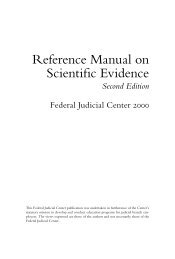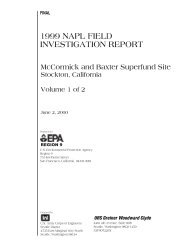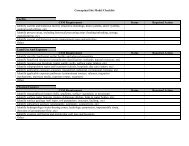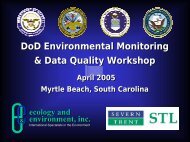Source Zone Delineation Demonstration Report - Triad Resource ...
Source Zone Delineation Demonstration Report - Triad Resource ...
Source Zone Delineation Demonstration Report - Triad Resource ...
Create successful ePaper yourself
Turn your PDF publications into a flip-book with our unique Google optimized e-Paper software.
5.2.1.3 Blower ComparisonTo compare the effects of blower size on the pneumatic response in the subsurface at OU 12, twodifferent blowers were used during vapor extraction operations at U12-VP1. The first blower(REGENAIR TM SD 4) was a three horsepower blower capable of exerting a vacuum of approximately 78inches of water (at the elevation of Hill AFB) measured at the blower intake. The second blower(REGENAIR TM R4) was a one horsepower blower capable of exerting a vacuum of approximately 48inches of water measured at the blower intake. The response of induced airflow as a function of appliedvacuum (vacuum measured at the well head to which the blower intake is attached) for both blowers isshown in Figure 5-29. Vacuum was stepped up in increments during testing and flow and vacuum wererecorded over time. The dilution attenuation valve was fully opened to the atmosphere at the start of eachstep test and was gradually closed to apply more vacuum to the well head. Air entering the dilutionattenuation valve entered downstream (i.e., adjacent to the blower intake) of the rotometer and thus, hadno impact on the measured airflow from the well head.As can be seen in Figure 5-29, a vacuum of approximately 25 to 29 inches of water applied to the wellhead was necessary to induce approximately two cfm of airflow through the vadose zone. As the vacuumapplied to the well head was increased to the maximum of the small blower's capacity (38 inches of waterat the well head and 48 inches of water at the blower intake), airflow increased to approximately 3 to 4cfm. The difference between the observed vacuum at the well head and the blower intake was associatedwith friction losses primarily through the rotometer whose rated friction loss is approximately 10 inchesof water. The pneumatic response in the vadose zone responded similarly when the large, threehorsepower blower was used to induce flow at U12-VP1. At 36 inches of applied vacuum, the airflowwas approximately 2.75 to 3 cfm. The maximum steady airflow observed during the test wasapproximately 8 cfm at 52 to 53 inches of applied vacuum measured at the well head (62 to 63 inches ofvacuum measured at the blower) using the three horsepower blower. There was one transient reading atthe well head when the vacuum reached 55 inches of water and flow was recorded at 9 cfm.The airflow as a function of applied vacuum was reproducible up to 3 cfm using both blowers. At anairflow rate of 3 cfm, the one horsepower blower had reached its full vacuum of 48 inches of water at theblower intake. Based on the response at U12-VP1, the one horsepower blower appears to be vacuumlimitedunder the site-specific conditions at OU 12. However, as discussed above, permeability changesmay be appreciable for soil vapor extraction operations conducted for extended periods of time due toLNAPL removal and/or the drying of the soil.A blower curve was not overlain with the system curve (i.e., pneumatic response of the vadose zone) togenerate an “operating point” because the applied vacuum was high for the limited flow observed at U12-VP1. This resulted in a limited range of the blower curve at which airflow could be plotted as a functionof applied vacuum. However, it is expected that the approximate operating point of the blower wouldextend slightly above 53 inches of applied vacuum because airflow was still increasing in proportion toapplied vacuum (see Figure 5-29).March 2003 5-42 OU 12 <strong>Demonstration</strong> <strong>Report</strong>Final










